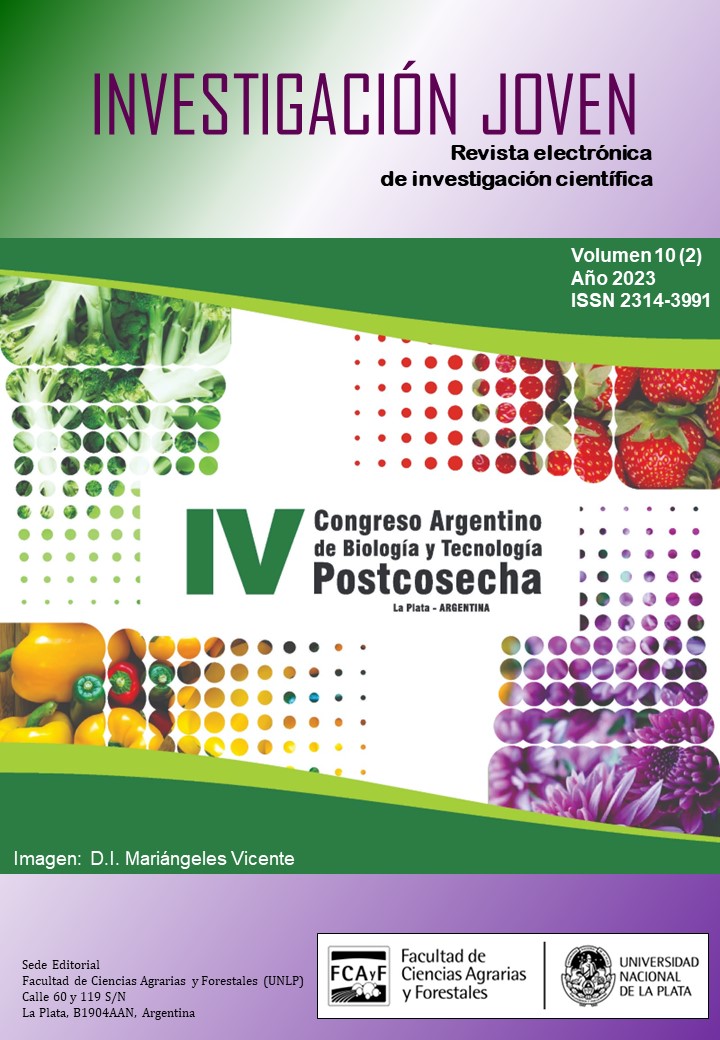Phytochemical profile of propolis from Santa Fe (Argentina) and antifungal potential against blueberry mycopathogens
Palabras clave:
postharvest, biopreservatives, phytopathogen, Vaccinium corymbosum L.Resumen
Argentina has started to produce blueberries in the last 20 years, and most of this production is destinated for exportation. Therefore, it is important that the quality remains during storage and shipping, especially preserving them from microbial growth. There has been a growing interest in alternative substances with antimicrobial activity in recent years. Therefore, the aim of this work was to study the antifungal potential of 4 different brown propolis samples (M1-M4) collected in Santa Fe, (Argentina), and characterize their chemical content. Humidity, waxes, resins, and residues content in raw samples were determined. The dry ethanolic extracts (EEP, 96%) were then analyzed by UV/Vis spectra, total phenolic content (TPC), total flavonoid content (TFC), and ABTS•+ free radical scavenging capacity. Additionally, the corresponding wax fraction was included and analyzed using FTIR-ATR spectroscopy, ls-NMR, and HRMS (High-resolution mass spectrometry). The in vitro antifungal activity of EEP was evaluated at 5 different concentrations by the agar well diffusion method against a previously isolated and identified group of blueberry mycopathogens. The test was carried out on PDA (25°C), and boscalid (0.2% w/w) (at 50%) was used as a positive control. Results showed that wax content ranged from 33,16 to 77, 95%. M4 exhibited the highest. In terms of resins (21,15-65,24%), M2 had the highest concentration. Finally, the lowest amount of residues (6,62-
12,22%) was found in M4, in contrast to M2 and M3. Concerning to TPC (191,91-228,51 mg Eq GA / g EEP) and TFC (28,86-33,89 mg Eq QUE / g EEP), the highest amounts were found in M3. The FTIR-ATR analysis and 1H-NMR spectra for the different propolis samples in DMSO-d6 were quite similar. On the other hand, HRMS experiments demonstrated the presence of flavonoids substances (M-H) such as garbanzol, prenyl caffeate, chrysin, pinocembrin, pinobanksin-3-acetate molecules together with some typical fatty acids (stearic and palmitic acids, M-H). Also, a stearoyl glycerol (an acylglycerol, M+Cl) was observed. Particularly, the propolis sample M1 contains a relatively higher content of flavonoids in comparison to M4 where the relative composition of lipids is high. Furthermore, the presence of 9-hydroxycalabaxanthone was detected along with the ions ascribed to fatty acids (myristic, palmitic, arachidic acids, M+NH4). Cladosporium cladosporioides was the only phytopathogenic fungi inhibited by the 4 different EEP. Although minor sporulation and mycelial growth halos were found in Botrytis cinerea and Alternaria tenuissima, they both were not inhibited by EEP, additionally, these phytopathogens showed resistance against boscalid. On the other hand, P. glabrum and P. auranteogriseum showed low susceptibility to EEP as well as moderate susceptibility to boscalid.
Descargas
Publicado
Número
Sección
Licencia
Derechos de autor 2023 J.P. Quintero-Cerón, J.M. Lázaro Martínez, C. Carrara, M.J. Spotti, L. Frison

Esta obra está bajo una licencia internacional Creative Commons Atribución-NoComercial-CompartirIgual 4.0.


















